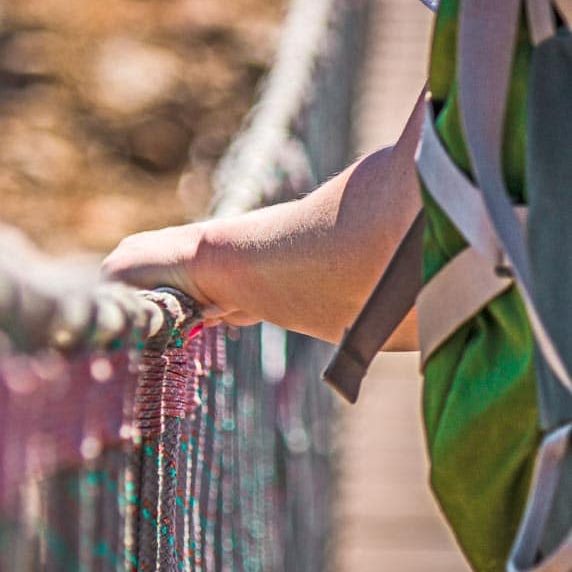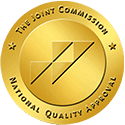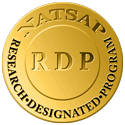
Hope and Healing: Treatment for Cutting & Self-harm in Teens
Self-harm, particularly cutting, is a growing concern among teens and as a parent, it can be difficult to know how to help. For teenagers, it may seem like a way to cope with emotional pain, but the reality is that self-harm can have long-lasting and even dangerous consequences. The good news is that wilderness therapy has been shown to help teens overcome this destructive behavior. In this article, we'll explore what self-harm is, why people cut themself, and treatment options that have been shown to be effective in treating cutting and self-harm in teens.
Or you can take our assessment for teenage self-harm & cutting and see if a wilderness therapy program is right for your family.
Self-harm in teens refers to the intentional and deliberate act of causing harm to one's own body as a way to cope with intense emotions, stress, or difficult life experiences. The most common forms of self-harm among teens include cutting, burning, and hitting oneself.
Although self-harm may provide temporary relief from emotional pain, it is a dangerous and potentially addictive behavior that can lead to serious health problems and long-term emotional damage. It is important for parents to be aware of the warning signs of self-harm and to seek professional help for teens who are struggling with this issue.
Signs Your Teen May Need Treatment for Cutting or Self-harm
While it may be difficult to spot, knowing the warning signs of teenage cutting and self-harm is key in getting your child the help they need to overcome this destructive behavior.
Warning signs of cutting and self-harm in teens can include:
- Unexplained cuts, bruises, or burns, particularly on the arms, legs, or torso
- Bloodstained or torn clothing or bedding
- Sharp objects or razors hidden in the room or belongings
- Avoiding activities that expose skin, such as wearing long sleeves in hot weather
- Low self-esteem, feelings of worthlessness, or depression
- Expressions of hopelessness or suicidal thoughts
- Changes in mood, eating, or sleeping habits
- Social withdrawal or isolation
If a parent suspects that their teen is engaging in cutting or self-harm, it is important to seek professional help. Some signs that a teen may need treatment include:
- Persistent self-harm behavior that is escalating in severity
- Engaging in self-harm in spite of a desire or efforts to stop
- Expressions of suicidal thoughts or desires
- Complete inability to regulate or manage emotions or stress
- Development of a mental health disorder such as depression or anxiety
It is important for parents to seek help from a mental health professional, such as a therapist, psychologist, or psychiatrist, who can provide a proper assessment and develop an effective treatment plan for their teen. Early intervention is key to preventing self-harm from becoming a chronic and harmful behavior.
Types of Self-harm in Teens
Also referred to as non-suicidal self-injury, self-harm in teens can take many different forms. Some of the more common types of self-harm include:
- Cutting: This involves using a sharp object, such as a razor blade or scissors, to make shallow or deep cuts on the skin.
- Burning: This involves using fire or a hot object, such as a lighter or cigarette, to burn the skin.
- Hitting or bruising: This involves hitting oneself with a blunt object, such as a fist or a book, or intentionally bruising oneself through rough physical activities.
- Carving or scratching: This involves using a sharp object to carve or scratch words or images into the skin.
- Interference with wound healing: This involves picking at or reopening wounds after they have started to heal.
- Hair pulling: This involves pulling out one's own hair, including eyebrows, eyelashes, or scalp hair.
- Excessive scratching: This involves excessive or repetitive scratching of the skin, often until it bleeds.
It is important to note that self-harm can take many different forms, and not all forms of self-harm may be immediately visible. Some teens may also engage in multiple forms of self-harm.
You Are Not Alone
RedCliff Ascent is there for you and your family.
Why Do People Cut Themself?
People who engage in self-harm, including cutting, may do so as a way to cope with intense emotions, stress, or difficult life experiences. Self-harm can serve as a means of releasing pent-up feelings or numbing emotional pain.
In some cases, self-harm can be a symptom of underlying mental health issues, such as depression, anxiety, borderline personality disorder, or post-traumatic stress disorder. For some individuals, self-harm may also be a way to feel a sense of control or to punish oneself for perceived mistakes or shortcomings.
It is important to understand that self-harm is not a sign of weakness or a deliberate attempt to seek attention, but rather a serious and complex issue that requires professional help. If you or someone you know is engaging in self-harm, it is important to seek the help of a mental health professional who can provide a proper assessment and develop an effective treatment plan.
The Connection Between Dopamine & Pain in the Teenage Brain
The relationship between pleasure and pain in the brain is complex and not fully understood. However, some research suggests that there may be overlap between the neural pathways involved in processing pleasure and pain. For some people, self-harm, including cutting, can release endorphins, which are natural painkillers produced by the body. Endorphins can produce a sense of pleasure or euphoria, which may explain why some people find self-harm to be addictive.
Additionally, self-harm may be associated with an increase in the neurotransmitter dopamine, which is involved in the brain's reward system. This release of dopamine can create a cycle of self-harm behavior as the individual seeks to repeat the pleasurable experience.
It is important to note that not everyone who engages in self-harm experiences pleasure or addiction, and that self-harm can also have serious physical and psychological consequences.

Importance of Early Intervention & Treatment for Cutting & Self-harm in Teens
Early intervention is important in treating teenage cutting & self-harm because it can help address the underlying issues that contribute to these behaviors and prevent them from becoming ingrained and difficult to change. By addressing the behavior early, parents can help their teen develop healthy coping mechanisms, improve their self-esteem, and develop better communication skills, all of which can reduce the compulsion for to cut or self-harm.
Early intervention and treatment for teenage cutting and self-harm is critical for several reasons:
- Physical health: Self-harm can lead to serious physical injuries and infections, as well as scarring and disfigurement. Early intervention can help prevent these consequences and ensure that any physical injuries are properly treated.
- Mental health: Self-harm is often a symptom of underlying mental health issues, such as depression, anxiety, or trauma. Early treatment can help address these underlying issues and prevent the development of more severe mental health problems.
- Prevention of escalation: Self-harm can be a repetitive and addictive behavior, and without intervention, it may escalate over time. Early treatment can interrupt this cycle and prevent the behavior from becoming more severe.
- Reduced risk of serious harm: When a teen engages in self-harm or cutting, there is always the possibility of unintended and severe physical harm, even if they are not suicidal. Early treatment helps lower this risk by educating teenagers on effective and safe ways to manage their emotions and stress.
- Improved quality of life: Early treatment for self-harm can help individuals develop more effective coping mechanisms, improve their emotional well-being, and increase their overall quality of life.
- Support: Early intervention can provide support to individuals and their families during a difficult and challenging time. This can help improve family relationships, reduce stress, and increase resilience.
It is important to seek help as soon as possible if you or someone you know is struggling with self-harm. Mental health professionals, such as therapists and psychiatrists, can provide a proper assessment and develop an effective treatment plan that may include therapy, medication, and other interventions.

Not Seeking Treatment Can Be Harmful
Untreated teenage cutting and self-harm can have both short-term and long-term effects, both physically and mentally.
Short-term effects of untreated grief may include:
- Physical injury: Cutting and other forms of self-harm can cause serious physical injuries and infections, which can be painful and potentially life-threatening.
- Emotional distress: Self-harm can increase anxiety and depression and make it more difficult for teens to cope with stress and emotions.
- Isolation: Teens who engage in self-harm may feel ashamed or embarrassed, which can lead to feelings of isolation and loneliness.
Long-term effects of untreated grief can include:
- Physical scarring: Self-harm can result in physical scarring and disfigurement, which can have a negative impact on self-esteem and body image.
- Mental health problems: Self-harm can be a symptom of underlying mental health issues, and without treatment, these issues may become more severe over time.
- Maladaptive Coping: Self-harm can be a repetitive and addictive behavior, and without intervention, it may escalate over time.
- Social and interpersonal problems: Self-harm can strain relationships with friends and family, and limit opportunities for education and employment.
Mental health professionals, such as therapists and psychiatrists, can provide a proper assessment and develop an effective treatment plan that may include therapy, medication, and other interventions.
Early Intervention Is Important For Healing Your Teen & Family
Early intervention refers to recognizing the warning signs of cutting and self-harm in teens and acting before it gets worse. When you realize that your teen is struggling, it’s important to get professional treatment before it becomes worse.
Early intervention can help parents and families of self-harming teenagers in several specific ways, including:
- Providing support and guidance: Early intervention can provide parents and families with the support and guidance they need to navigate the situation effectively. This can include information on effective communication strategies, coping skills, and resources available to help manage the situation.
- Improving relationships: Early intervention can help improve relationships between parents, teenagers, and other family members. This can include teaching parents how to better understand and communicate with their teen while also improving the teenager's relationships with their peers and family members.
- Reducing stress for the whole family: Early intervention can help reduce stress and anxiety for parents and other family members, as well as for the teenager themselves. By receiving support and guidance, families can feel more confident and better equipped to manage the situation effectively.
- Preventing further harm: Early intervention can help prevent further harm to the teenager and the family. This can include addressing behavioral issues before they escalate and helping the teenager access the resources and support they need to overcome challenges.
- Building resilience: Early intervention can help build resilience and coping skills in parents and family members, which can help them better manage stress and challenges in the future.
- Improving overall well-being: Early intervention can help improve the overall well-being of everyone involved. By addressing teen cutting & self-harm early on, families can take an important step toward promoting positive mental health and well-being for all members of the household.
Plus, it could help reduce long-term medical costs and the overall burden on family and friends. Overcoming self-harm in teens is possible with the right tools and treatment programs. You can help your teen get the support they need.
Treatment for Cutting & Self-harm in Teens: What Are Your Options?
There are several treatment options available to parents of teens struggling with cutting and self-harm, including:
- Outpatient therapy: This type of therapy involves regular sessions with a mental health professional, typically once a week or more.
- Day treatment: Day treatment programs provide intensive therapy and support for teens, but allow them to return home at night.
- Inpatient treatment: Inpatient treatment involves hospitalization for a period of time, typically 1-2 weeks, and provides 24/7 supervision and care.
- Residential treatment: Residential treatment programs provide round-the-clock care in a therapeutic and structured environment, typically lasting several months.
- Wilderness therapy: This type of therapy combines traditional therapy with outdoor activities, such as hiking and camping, and can be a highly effective form of treatment for teens struggling with self-harm.
The type of treatment that is most appropriate for a teen will depend on the severity of their symptoms, their underlying mental health conditions, and other factors. It is important to consult with a mental health professional to determine the best course of action.
What is Wilderness Therapy?
Wilderness therapy is a type of program for teens struggling with cutting & self-harm that uses nature, wilderness activities, and therapy as a means to address and heal their individual struggles. Wilderness therapy takes full advantage of the outdoors and its ability to foster change. The outdoors provide teens with a contrasting environment to observe aspects of themselves that are often overlooked in traditional talk therapy.
As the leader in wilderness therapy, RedCliff Ascent is an effective treatment program for struggling teens aged 13-17. RedCliff Ascent’s safe, nurturing, and supportive environment provides teens with the skills they need to cope with overwhelming emotions & stress in a healthy and age-appropriate way.

Benefits of Wilderness Therapy for Treating Cutting & Self-harm in Teens
Being immersed in nature can have a profound impact on a teenager. It improves their mental, emotional and physical health. When combined with a research-backed clinical approach, a therapeutic wilderness experience helps heal teens and their families. Here are five specific benefits your family can expect to see while your teen is in wilderness therapy.
Cutting and self-harm in teens is often a symptom of deeper mental health struggles rather than the cause of them. Research indicates accurate mental health assessments can lead to a 20% reduction in treatment.
Wilderness therapy provides a novel and challenging environment that disrupts the unhealthy patterns that cause your teen's self-harm or are a result of your teen's cutting & self-harm.
Teen who self-harm often struggle to engage in ongoing treatment and have very high dropout rates. Poor engagement may lead to worse clinical outcomes, with symptom relapse and rehospitalization. Our research shows that even teens who have been resistant to therapy engage in the process while in wilderness therapy.
RedCliff Ascent’s safe, nurturing, and supportive environment provides teens with the social and emotional learning skills they need to positively cope with their strong emotions and re-engage in healthy development.
If you're like most parents, you don't want to just heal your teen's cutting and self-harm. You want them to eventually become thriving, healthy, independent adults equipped with the skills necessary to succeed outside your home. These include:
Resilience - the ability to successfully adapt to challenging situations despite risk and adversity. Resilience helps us develop social competence, problem-solving skills, critical consciousness, autonomy, and a sense of purpose.
Leadership & Social Competence skills include qualities such as:
- responsiveness, especially the ability to elicit positive responses from others
- flexibility
- empathy
- communication skills
- and a sense of humor
Problem-solving skills - the ability to plan; to be resourceful in seeking help from others; and to think critically, creatively, and reflectively.
Autonomy is having a sense of one’s own identity and an ability to act independently and to exert some control over one’s environment, including a sense of task mastery, internal locus of control, and self-efficacy. The development of resistance (refusing to accept negative messages about oneself) and of detachment (distancing oneself from dysfunction) serves as a powerful protector of autonomy.
Sense of Purpose and a belief in a bright future, including goal direction, educational aspirations, achievement motivation, persistence, hopefulness, optimism, and spiritual connectedness.
98% of students report feeling connected to RedCliff's staff and one or more of their peers.
Upon completion of the program, 86% of parents reported improvement in their child's problems when compared to when they entered
12 months after treatment 86% of parents reported that their child's problems are improved since they completed treatment
How Does Wilderness Therapy Work?
RedCliff Ascent has helped teens struggling with cutting and self-harm for almost 30 years and has conducted research since its inception. Through our research, we have identified seven principles that actually make a difference in helping your whole family recover from your teen's struggles.

Healthy relationships are not only the foundation for growth and development but the launchpad for a successful future as well.
Your teen will live in a small group where social influence and feedback can be given and received in a safe and supportive way. This safe environment teaches your teen to build healthy relationships with both their peers and mentors. Having the skills to make and keep healthy relationships is essential to overcoming cutting and self-harm in teens.
Teen treatment is most effective when it is responsive to your teen’s specific struggles, strengths, personality, sociocultural context, and preferences. Our evidence-based treatment approach combines decades of research and clinical expertise to personalize a treatment plan that fits your teen’s unique struggles, characteristics, culture, and preferences.
One common theme in feedback from RedCliff Ascent’s students is that the challenging and novel environment provided them with a new perspective on their life and everything they knew before wilderness therapy.
Novel physical environments are a place of contrast that confront the world views your teen takes for granted. This helps your teen to see with a fresh perspective and see new options available to them. Growth occurs outside of the comfort zone and is accelerated in environments that push physical and mental limits.
Your teen's struggles with cutting and self-harm didn't develop in isolation, it affects everyone in your family. The healing process should apply to your whole family as well. Parental involvement and family support during treatment greatly increase your teen’s progress in treatment and helps them to adapt after treatment.
Communicating through handwritten letters provides a novel and powerful way to work through your family's struggles. You will also have access to our parent resource library, a weekly support call with other parents like you, as well as a weekly session with your child's therapist.
Teenage cutting and self-harm affect every aspect of their life. The best treatment programs must heal every part of their life as well. They use a holistic and integrated approach so that every aspect of your teen's life can heal from the effects of self-harm. In our treatment program, mentors, therapists, doctors, nurses, academic directors, nutritionists, and everyone on your teen's treatment team will meet together each week to discuss how to best help your child.
Manipulative teens struggle to believe in themselves. By teaching basic primitive living skills, teens gain a confidence in themselves that carries on to all aspects of their lives. By knowing that they are able to survive in nature, teens thrive at home, in school, and in their relationships.
A ceremony is a powerful tool that can change your teenager's life. A ceremony is a community celebration or commemoration often having symbolic importance to the people performing it. A ceremony recognizes your teen's inner growth and experiences and attaches it to a physical symbol that your teen can take with them. A ceremony can help your teen validate and internalize the growth they have achieved.
Exclusionary criteria for RedCliff Ascent include:
- Teens younger than 13 and older than 17.5
- Teens with a physical limitation, i.e. wheelchair, crutches, etc.
- Teens with conditions that need intensive medical care or monitoring, i.e. eating disorders, diabetes, etc.
- Teens with a history of violence or sexual assault
- Teens with psychosis or schizophrenia
RedCliff Ascent does not take Medicare or Medicaid.
What Our Clients Say About RedCliff Ascent
I’d like to let you know how delighted I am with the RedCliff program and how impressive the hard work and dedication of the staff is...We feel that your program has very probably saved this child’s life and given us back our son.
- Kathy
We are very pleased with [our daughter's] self-improvements. A year ago we would not have dreamed all this to be possible! The path she head down was self-destruction. The impact of the RedCliff program is what turned [her] around. Our headstrong daughter was able to take stock of her past behavior, deal with her anger towards us, and begin to move in a more positive direction.
Even though sending her to RedCliff was a gut-wrenching decision, we know we did the right thing. We are thankful for the help and insight you gave to her and us.
- Clark and Irene
Since [our son] went to RedCliff we have all been transformed, but none as much as he. All of his teachers had nothing but good things to say about him. There have been no behavior issues at school this year. As a matter of fact, his teachers stated that they would like it if they had more students like Rob in their classes. I cried again at this meeting, but this time they were tears of joy.
- Julie


Backed by The Joint Commission which ensures programs adhere to the highest quality of clinical and medical practices.

Designated as a NATSAP Research Program, showing our commitment to well-researched practices in our program.

We are also OBH Accredited through the Association of Experiential Education (AEE) which regulates wilderness therapy practices.

Full member of the National Association of Therapeutic Schools and Programs (NATSAP), which ensure regulation of programs that serve children and adolescents.

RedCliff Ascent is fully licensed in the state of Utah.

Backed by the Association of Experiential Education (AEE) that ensures programs maintain appropriate professional behavior and risk management.

Founding member of the OBH Council (Outdoor Behavioral Healthcare Council).

Founding member of Choose Mental Health, guiding families with questions about mental health.
Every teen’s strengths and challenges are different. Complete the no-obligation teen assessment below to help us understand your family’s needs.
We respect your privacy and will never share your information.
We’re here to help - take the first step and contact us to see if wilderness therapy could be the path to healing for your family.
